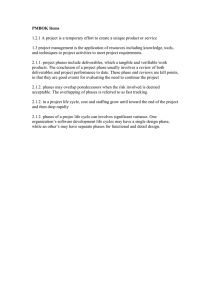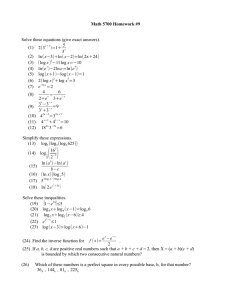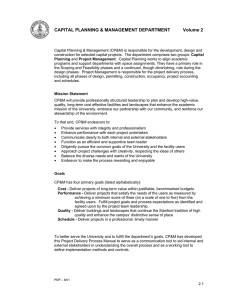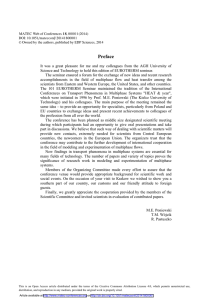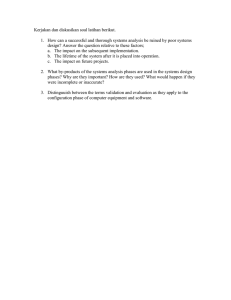Discovering New Oxides
advertisement
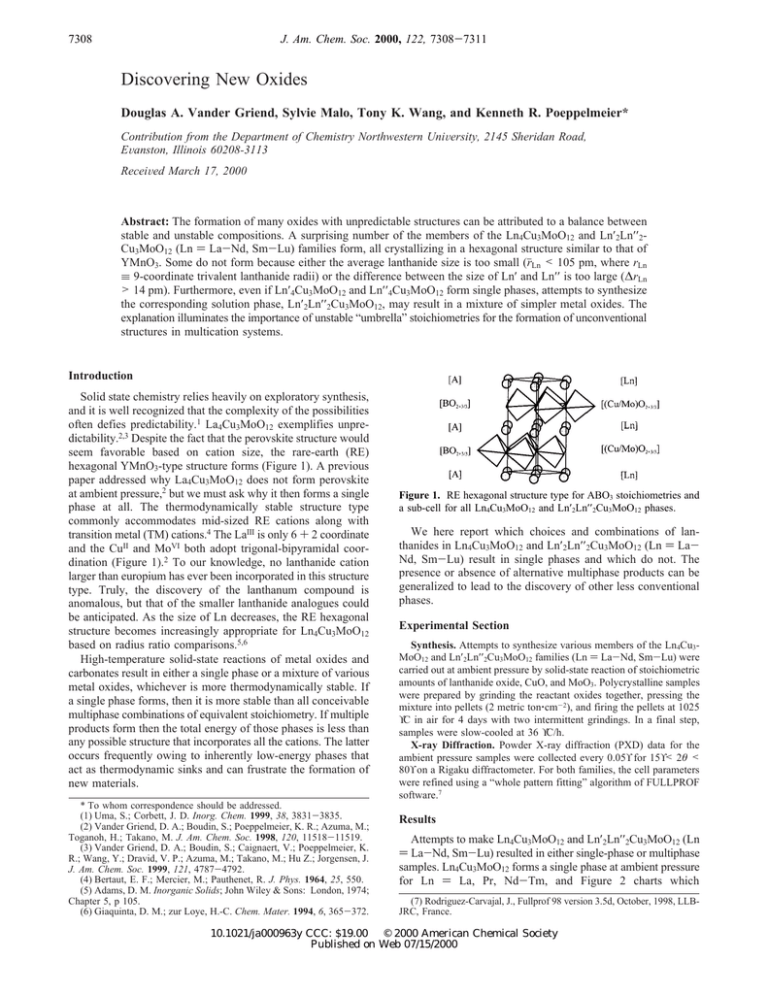
7308 J. Am. Chem. Soc. 2000, 122, 7308-7311 Discovering New Oxides Douglas A. Vander Griend, Sylvie Malo, Tony K. Wang, and Kenneth R. Poeppelmeier* Contribution from the Department of Chemistry Northwestern UniVersity, 2145 Sheridan Road, EVanston, Illinois 60208-3113 ReceiVed March 17, 2000 Abstract: The formation of many oxides with unpredictable structures can be attributed to a balance between stable and unstable compositions. A surprising number of the members of the Ln4Cu3MoO12 and Ln′2Ln′′2Cu3MoO12 (Ln ) La-Nd, Sm-Lu) families form, all crystallizing in a hexagonal structure similar to that of YMnO3. Some do not form because either the average lanthanide size is too small (rjLn < 105 pm, where rLn ≡ 9-coordinate trivalent lanthanide radii) or the difference between the size of Ln′ and Ln′′ is too large (∆rLn > 14 pm). Furthermore, even if Ln′4Cu3MoO12 and Ln′′4Cu3MoO12 form single phases, attempts to synthesize the corresponding solution phase, Ln′2Ln′′2Cu3MoO12, may result in a mixture of simpler metal oxides. The explanation illuminates the importance of unstable “umbrella” stoichiometries for the formation of unconventional structures in multication systems. Introduction Solid state chemistry relies heavily on exploratory synthesis, and it is well recognized that the complexity of the possibilities often defies predictability.1 La4Cu3MoO12 exemplifies unpredictability.2,3 Despite the fact that the perovskite structure would seem favorable based on cation size, the rare-earth (RE) hexagonal YMnO3-type structure forms (Figure 1). A previous paper addressed why La4Cu3MoO12 does not form perovskite at ambient pressure,2 but we must ask why it then forms a single phase at all. The thermodynamically stable structure type commonly accommodates mid-sized RE cations along with transition metal (TM) cations.4 The LaIII is only 6 + 2 coordinate and the CuII and MoVI both adopt trigonal-bipyramidal coordination (Figure 1).2 To our knowledge, no lanthanide cation larger than europium has ever been incorporated in this structure type. Truly, the discovery of the lanthanum compound is anomalous, but that of the smaller lanthanide analogues could be anticipated. As the size of Ln decreases, the RE hexagonal structure becomes increasingly appropriate for Ln4Cu3MoO12 based on radius ratio comparisons.5,6 High-temperature solid-state reactions of metal oxides and carbonates result in either a single phase or a mixture of various metal oxides, whichever is more thermodynamically stable. If a single phase forms, then it is more stable than all conceivable multiphase combinations of equivalent stoichiometry. If multiple products form then the total energy of those phases is less than any possible structure that incorporates all the cations. The latter occurs frequently owing to inherently low-energy phases that act as thermodynamic sinks and can frustrate the formation of new materials. * To whom correspondence should be addressed. (1) Uma, S.; Corbett, J. D. Inorg. Chem. 1999, 38, 3831-3835. (2) Vander Griend, D. A.; Boudin, S.; Poeppelmeier, K. R.; Azuma, M.; Toganoh, H.; Takano, M. J. Am. Chem. Soc. 1998, 120, 11518-11519. (3) Vander Griend, D. A.; Boudin, S.; Caignaert, V.; Poeppelmeier, K. R.; Wang, Y.; Dravid, V. P.; Azuma, M.; Takano, M.; Hu Z.; Jorgensen, J. J. Am. Chem. Soc. 1999, 121, 4787-4792. (4) Bertaut, E. F.; Mercier, M.; Pauthenet, R. J. Phys. 1964, 25, 550. (5) Adams, D. M. Inorganic Solids; John Wiley & Sons: London, 1974; Chapter 5, p 105. (6) Giaquinta, D. M.; zur Loye, H.-C. Chem. Mater. 1994, 6, 365-372. Figure 1. RE hexagonal structure type for ABO3 stoichiometries and a sub-cell for all Ln4Cu3MoO12 and Ln′2Ln′′2Cu3MoO12 phases. We here report which choices and combinations of lanthanides in Ln4Cu3MoO12 and Ln′2Ln′′2Cu3MoO12 (Ln ) LaNd, Sm-Lu) result in single phases and which do not. The presence or absence of alternative multiphase products can be generalized to lead to the discovery of other less conventional phases. Experimental Section Synthesis. Attempts to synthesize various members of the Ln4Cu3MoO12 and Ln′2Ln′′2Cu3MoO12 families (Ln ) La-Nd, Sm-Lu) were carried out at ambient pressure by solid-state reaction of stoichiometric amounts of lanthanide oxide, CuO, and MoO3. Polycrystalline samples were prepared by grinding the reactant oxides together, pressing the mixture into pellets (2 metric ton‚cm-2), and firing the pellets at 1025 °C in air for 4 days with two intermittent grindings. In a final step, samples were slow-cooled at 36 °C/h. X-ray Diffraction. Powder X-ray diffraction (PXD) data for the ambient pressure samples were collected every 0.05° for 15°< 2θ < 80° on a Rigaku diffractometer. For both families, the cell parameters were refined using a “whole pattern fitting” algorithm of FULLPROF software.7 Results Attempts to make Ln4Cu3MoO12 and Ln′2Ln′′2Cu3MoO12 (Ln ) La-Nd, Sm-Lu) resulted in either single-phase or multiphase samples. Ln4Cu3MoO12 forms a single phase at ambient pressure for Ln ) La, Pr, Nd-Tm, and Figure 2 charts which (7) Rodriguez-Carvajal, J., Fullprof 98 version 3.5d, October, 1998, LLBJRC, France. 10.1021/ja000963y CCC: $19.00 © 2000 American Chemical Society Published on Web 07/15/2000 DiscoVering New Oxides J. Am. Chem. Soc., Vol. 122, No. 30, 2000 7309 Figure 2. Chart of Ln4Cu3MoO12 and Ln′2Ln′′2Cu3MoO12 synthesis attempts. Light gray squares indicate single-phase products. Squares crossed with an “X” indicate multiphase products comprised solely of metal and binary metal oxides. Open squares indicate multiphase products where one of the phases has the targeted RE hexagonal structure. Squares marked with an asterisk are anticipated results in accordance with experimental results (rjLn g rTm ) 105 pm and ∆rLn e 14 pm where rLn ≡ 9-coordinate radii). Figure 4. Graphs of (a) the monoclinic lattice parameters and (b) the unit cell volume for Ln4Cu3MoO12 and Ln′2Ln′′2Cu3MoO12 as a function of 9-coordinate trivalent lanthanide radii. Figure 3. Powder X-ray diffraction patterns for Ln4Cu3MoO12 (Ln ) La, Pr, Nd, Sm-Tm). combinations of Ln′2Ln′′2Cu3MoO12 form a single phase according to PXD. Multiphase samples were further classified by the presence of a phase with the targeted RE hexagonal structure. The open squares of Figure 2 indicate nine such samples. The squares crossed with an ”X“ indicate multiphase samples of only binary or single metal oxides. The PXD patterns of all single-phase samples are similar to that of the original lanthanum sample indicating that they crystallize in the same structure type (Figure 3). The gradual shift in the peak positions reveals the evolution of the lattice parameters for different lanthanides. The subcell for La4Cu3MoO12 is hexagonal (P63/mmc, a ) 3.953(1) Å, c ) 11.000(1) Å), and a previous paper disclosed the superstructural details.3 The best refinement of powder neutron and X-ray diffraction data yielded a quadrupled supercell (P21/m, a ) 7.9125(4) Å, b ) 11.0113(2) Å, c ) 6.8503(4) Å, and β ) 90.027(7)°) with dimensions am ) 2ah, cm ) x3bh, and bm ) ch, where the m and h subscripts stand for monoclinic and hexagonal, respectively.3 The unit cells for the compounds reported in this paper were refined first in the hexagonal space group (P63/mmc) and then in the monoclinic one (P21/m) using orthogonalized parameters from the first stage as a starting point for the final stage. Attempts to refine the monoclinic cell directly were often thwarted by the presence of local minima. The results of the refinements are tabulated in the Supporting Information. Figure 4a shows the graph of the monoclinic unit cell dimensions (all β ≈ 90°), and Figure 4b shows the graph of the unit cell volume. All vary linearly with average A-cation size. The lattice parameters for Ln′2Ln′′2Cu3MoO12 members correspond approximately to the average of the two end members, Ln′4Cu3MoO12 and Ln′′4Cu3MoO12, as indicated by the linearity of the plots. The basal plane parameters (a and c) decrease with decreasing lanthanide size as expected, whereas the b parameter increases. This can be explained by examining the anisotropy of this structure type. The LnIII cations form a hexagonal array in the basal plane of the structure that sandwiches the B-cation trigonal bipyramids (Figure 1). The dimensions in the basal plane decrease as the lanthanide cations sit closer together. The apexes of the trigonal bipyramids that nestle between three lanthanide cations are consequently forced away from the basal plane elongating the cell in the b-direction. The supercell for La4Cu3MoO12 results from the ordered arrangement of the molybdenums in the B-cation plane.3 While the basic structure type and atomic coordination for all of the lanthanide analogues (Ln4Cu3MoO12) appear the same, the structures with smaller lanthanides deviate from the monoclinic model. This is evidenced by the splitting of many of the PXD peaks for the smaller lanthanide phases (Figure 3). There remain some superstructural features in these small lanthanide members to be solved. Small low-angle peaks suggest the presence of yet a larger supercell in those cases, which could be hexagonal. Ln4Cu3MoO12 analogues with Ce, Yb, or Lu do not form under comparable conditions. In the case of cerium, its affinity for the 4+ oxidation state destabilizes the target phase. Attempts to synthesize Ce4Cu3MoO12 under reducing conditions (7% H2) also failed to produce a single phase. This is not unexpected 7310 J. Am. Chem. Soc., Vol. 122, No. 30, 2000 since the equilibrium for the reduction of CuII to CuI at 1250 K (log(PO2) ) -0.7) is 16 orders of magnitude greater than that for CeIV to CeIII (log(PO2) ) -16.5).8 The attempts to make Yb and Lu analogues resulted in mixtures of simple metal oxides (Figure 2). It can be concluded that they are too small to stabilize this structure type, since they typically form a different structure for ABO3 stoichiometries.9,10 No Ln′2Ln′′2Cu3MoO12 phases form with Yb or Lu either. Only two different A-cation compositions have been dealt with to this point: pure Ln and 50/50 Ln′/Ln′′ mixtures. We expect that if Ln′2Ln′′2Cu3MoO12 forms, then isomorphic solid solution phases with other Ln′/Ln" ratios will form as well. Additionally, phases with other Ln′/Ln′′ ratios may well form as one of several in a mixture. For example, the attempt to synthesize La2Dy2Cu3MoO12 resulted in a multiphase sample with one phase that resembled the target phase in the structure. Since it is not the only phase, the distribution of the two lanthanide cations is likely something other than the starting composition. The lattice parameters (a ) 7.615(1) Å, b ) 11.181(1) Å, c ) 6.600(1) Å, and β ) 90.37(4)°, P21/m) lie between the lattice parameters of La4Cu3MoO12 and Dy4Cu3MoO12, but the presence of a significant amount of Dy2Cu2O5 in the powder pattern indicates that the A-cation composition of the phase with the target structure is about 70% lanthanum. The nine open squares of Figure 2 mark the multiphase results where one of the phases had the RE hexagonal structure. Six of these involved ytterbium, suggestive of target structures with some proportion of Yb on the A-cation site. Discussion The structures reported here all resemble the RE hexagonal structure type for ABO3 phases according to the PXD data. It was previously known with lanthanides from Eu to Tm as A-cations and a variety of transition metals as B-cations.4 The Ln4Cu3MoO12 and Ln′2Ln′′2Cu3MoO12 families represent the first examples which accommodate larger RE cations, but this particular B-cation composition (75% copper and 25% molybdenum) could not extend the stability of this structure to the two smallest lanthanides, Yb and Lu. While not the first examples to incorporate multiple B-cations,11 these phases are the first reported examples to exhibit significant deviation from hexagonal symmetry owing to the ordered arrangement of the B-cations. The attempt to make La2Ho2Cu3MoO12 did not result in a single phase. Surprisingly, it also did not result in the segregation of the two parent phases, La4Cu3MoO12 and Ho4Cu3MoO12, both of which form under identical conditions. Furthermore, no phase with the targeted RE hexagonal structure formed. The result was an ordinary set of simple oxides: La2MoO6, CuO, and Ho2Cu2O5. The same result proved true for the other combinations of Ln′ and Ln′′ where the size mismatch between the lanthanides was too large (∆rLn > 14 pm, where rLn ≡ 9-coordinate trivalent lanthanide size). Figure 2 codes all the experimental results for the Ln′2Ln′′2Cu3MoO12 family. Additional results (marked with an asterisk) are anticipated based on two requirements for the formation of a single phase: (1) sufficiently large average (8) Reed, T. B. Free Energy of Formation of Binary Compounds: An Atlas of Charts for High-Temperature Chemical Calculations; MIT Press: Cambridge, 1971; Chapter 7. (9) Schneider, S. J.; Roth, R. S.; Waring, J. L. J. Res. Natl. Bur. Stand. 1961, 65A, 345. (10) Yakel, H. L.; Koehler, W. C.; Bertaut, E. F.; Forrat, E. F. Acta Crystallogr. 1963, 16, 957. (11) Anderson, M. T.; Greenwood, K. B.; Taylor, G. A.; Poeppelmeier, K. R. Prog. Solid State Chem. 1993, 22, 197-233. Vander Griend et al. Figure 5. Graph of qualitative stabilities for “Ln4(Cu/Mo)4O12” stoichiometries. Single-phase materials form for Cu/Mo ) 3/1 even when either Ln2Cu2O5 (Cu/Mo ) ∞) or Ln2MoO6 + CuO (Cu/Mo ) 1) is more stable. The multiphase line is the average of the Ln2Cu2O5 (100% copper) and the Ln2MoO6 + CuO (50% copper) line and lies above the single-phase line except for Ln ) Yb and Lu. lanthanide size (rjLn g rTm ) 105 pm) and (2) sufficiently small difference between the lanthanide cation sizes (∆rLn e 14 pm). The explanation for this unexpected result leads to the principle of “umbrella” stoichiometries that can be used to direct both cuprate syntheses and solid-state syntheses in general. The fact that an ordinary set of products forms when targeting La2Ho2Cu3MoO12 illustrates the peculiarity of single-phase compositions such as La4Cu3MoO12 and Ho4Cu3MoO12. The specific oxide compositions that form as the thermodynamic products define a stability hierarchy. Ln2Cu2O5 must be especially stable for smaller lanthanides (green phase), and likewise Ln2MoO6 must be especially stable for larger lanthanides. If this were not true, then the segregation of the two parent phases would be the most stable multiphase result. Conversely, Ln2Cu2O5 must be relatively unstable for larger lanthanides and Ln2MoO6 for smaller lanthanides. Ln4Cu3MoO12 represents a stoichiometry that is couched between the stability of Ln2Cu2O5 and Ln2MoO6 + CuO. All three stoichiometries (Ln4Cu3MoO12, Ln2Cu2O5, and Ln2MoO6 + CuO) represent Ln(Cu/Mo)O3 stoichiometries differing only in the ratio of CuII to MoVI. Figure 5 is a qualitative stability diagram for such stoichiometries. Ln2Cu2O5 (100% of the TM cations are copper) is more stable than Ln4Cu3MoO12 (75% of the TM cations are copper) on the right side of the diagram and less stable on the left. The opposite is true for Ln2MoO6 + CuO (50% Cu of the TM cations are copper). The specific 3 to 1 ratio of copper to molybdenum in Ln4Cu3MoO12 permits the formation of the single phase by rendering all sets of multiple products less stable than the single phase. Despite an oxide that is more stable than the single phase, the hypothetical leftover is too unstable. The multiphase product, which corresponds to the midpoint between Ln2Cu2O5 and Ln2MoO6 + CuO, is less stable than the single-phase product except for Ln ) Yb and Lu. For Ln ) La-Tm, a single phase forms as the thermodynamic product, and for the larger lanthanides, this phase forms despite inappropriate cation sizes because the stoichiometry renders all other possibilities even less stable. Without any low-energy alternatives, La4Cu3MoO12 is required to crystallize in the rare earth hexagonal structure even though the lanthanum is only 6 + 2 coordinate and the copper and molybdenum are in fairly unusual trigonal bipyramidal coordination. The structural unconventionality of this phase is directly attributable to its proximity to the unstable composition La2Cu2O5. The situation is reversed for Ho4Cu3MoO12 where Ho2MoO6 is the unstable composition. DiscoVering New Oxides The drawing of Figure 5 is qualitative in nature and is meant to help explain the stability of the Ln4Cu3MoO12 and Ln′2Ln′′2Cu3MoO12 phases. The small lanthanides prefer to pair up with the copper, while the large ones prefer the molybdenum. We observe that there exists a range of intermediate ratios between 100% copper and 50% copper for the B-cation composition that allows for the formation of a new single phase if the two lanthanides are close enough in size. If either Ln2Cu2O5 or Ln2MoO6 were to form, then the leftover stoichiometry is restrictively unstable. However, if the two lanthanides differ sufficiently in size then Ln2Cu2O5 and Ln2MoO6 are stabilized. This is the case for La/Ho, which yields Ho2Cu2O5 + La2MoO6 + CuO, and the other stoichiometries represented in the lower lefthand corner of Figure 2. The large lanthanide cation reacts to from a pure molybdate, while the smaller one reacts to form a pure cuprate. This system illustrates how unstable stoichiometries, here termed “umbrella” stoichiometries, promote the formation of unexpected structures and complex compositions by counterbalancing thermodynamic sinks. Lanthanide copper molybdates form in the absence of stable multiphase alternatives. Obviously, a single thermodynamic phase forms only if it is more stable than all possible mixtures of products for a given set of reaction conditions. What this means to the synthetic chemist is that undiscovered phases likely exist near relatively unstable stoichiometries. LaIII and CuII in a 1 to 1 ratio or less is one such stoichiometry. HoIII and MoVI in a 2 to 1 ratio or less is another. These stoichiometries offset stable ones such as HoIII and CuII in a 1 to 1 ratio and LaIII and MoVI in a 2 to 1 ratio. The result is simple, but its application to other systems is powerful. An umbrella stoichiometry is the inverse of a thermodynamic sink. The latter can frustrate attempts to make (12) Anderson, M. T.; Poeppelmeier, K. R.; Zhang, J. P.; Fan, H.-J.; Marks, L. D. Chem. Mater. 1992, 4, 1305-1313. (13) Anderson, M. T.; Poeppelmeier, K. R. Chem. Mater. 1991, 3, 476482. J. Am. Chem. Soc., Vol. 122, No. 30, 2000 7311 compounds of comparable stoichiometries. In contrast, an “umbrella” stoichiometry increases the likelihood of finding new compounds nearby by creating a pocket of stability. It can be used to overcome the formation of prevalent sinks. The formation of La2Ba2Cu2Ti2O11 can be attributed to such a stoichiometric balance.12 BaTiO3 is a very stable binary product that could result from that stoichiometry, but the instability of what would remain, La2Cu2O5, causes nature to find another alternative. La2CuSnO6 is another example.13 The stable pyrochlore La2Sn2O7 does not form so that La2Cu2O5 does not have to either. The discovery of La4Cu3MoO12 could not be anticipated because of seemingly unstable features of the ambient pressure structure. However, as discussed in this paper, the La/Cu “umbrella” stoichiometry facilitates the formation of a single phase by destabilizing all multiphase alternatives. The usefulness of the concept is 2-fold: known single-phase stoichiometries can be modified with substitutions that shift them toward “umbrella” stoichiometries, and the many phases that remain undiscovered are more likely to be found close to such stoichiometries. Acknowledgment. This material is based upon work supported under a National Science Foundation (NSF) graduate fellowship for D.A.V.G. NSF also supported this work through the Science and Technology Center for Superconductivity (NSF Award No. DMR-9120000) and the Central Facilities at the Materials Research Center at Northwestern University (NSF Award No. DMR-9620521). T.K.W. participated in the 1999 NSF Solid State Chemistry REU Summer Research Program. Supporting Information Available: Table of unit cell parameters for all Ln4Cu3MoO12 and Ln′2Ln′′2Cu3MoO12 phases that formed (PDF). This material is available free of charge via the Internet at http://pubs.acs.org. JA000963Y


